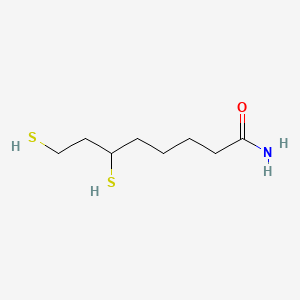| MeSH term | MeSH ID | Detail |
|---|---|---|
| Parkinsonian Disorders | D020734 | 20 associated lipids |
Dihydrolipoamide
Dihydrolipoamide is a lipid of Fatty Acyls (FA) class. Dihydrolipoamide is associated with abnormalities such as Wiskott-Aldrich Syndrome. The involved functions are known as Citric Acid Cycle, Electron Transport, NADH oxidation, Oxidation and Oxidants. Dihydrolipoamide often locates in Mitochondria, Mitochondrial matrix and Chloroplasts. The associated genes with Dihydrolipoamide are Mutant Proteins, Recombinant Proteins, mycothione reductase, Genes, Mitochondrial and alanylproline.
Cross Reference
Introduction
To understand associated biological information of Dihydrolipoamide, we collected biological information of abnormalities, associated pathways, cellular/molecular locations, biological functions, related genes/proteins, lipids and common seen animal/experimental models with organized paragraphs from literatures.
What diseases are associated with Dihydrolipoamide?
Dihydrolipoamide is suspected in and other diseases in descending order of the highest number of associated sentences.
Related references are mostly published in these journals:
| Disease | Cross reference | Weighted score | Related literature |
|---|
Possible diseases from mapped MeSH terms on references
We collected disease MeSH terms mapped to the references associated with Dihydrolipoamide
PubChem Associated disorders and diseases
What pathways are associated with Dihydrolipoamide
There are no associated biomedical information in the current reference collection.
PubChem Biomolecular Interactions and Pathways
Link to PubChem Biomolecular Interactions and PathwaysWhat cellular locations are associated with Dihydrolipoamide?
Visualization in cellular structure
Associated locations are in red color. Not associated locations are in black.
Related references are published most in these journals:
| Location | Cross reference | Weighted score | Related literatures |
|---|
What functions are associated with Dihydrolipoamide?
Related references are published most in these journals:
| Function | Cross reference | Weighted score | Related literatures |
|---|
What lipids are associated with Dihydrolipoamide?
There are no associated biomedical information in the current reference collection.
What genes are associated with Dihydrolipoamide?
Related references are published most in these journals:
| Gene | Cross reference | Weighted score | Related literatures |
|---|
What common seen animal models are associated with Dihydrolipoamide?
There are no associated biomedical information in the current reference collection.
NCBI Entrez Crosslinks
All references with Dihydrolipoamide
Download all related citations| Authors | Title | Published | Journal | PubMed Link |
|---|---|---|---|---|
| Ojha S et al. | Evolution of function in the "two dinucleotide binding domains" flavoproteins. | 2007 | PLoS Comput. Biol. | pmid:17658942 |
| Leichert LI and Jakob U | Protein thiol modifications visualized in vivo. | 2004 | PLoS Biol. | pmid:15502869 |
| Moran JF et al. | Molecular cloning, functional characterization, and subcellular localization of soybean nodule dihydrolipoamide reductase. | 2002 | Plant Physiol. | pmid:11788775 |
| Chen W et al. | Disruption of ptLPD1 or ptLPD2, genes that encode isoforms of the plastidial lipoamide dehydrogenase, confers arsenate hypersensitivity in Arabidopsis. | 2010 | Plant Physiol. | pmid:20488895 |
| Lutziger I and Oliver DJ | Characterization of two cDNAs encoding mitochondrial lipoamide dehydrogenase from Arabidopsis. | 2001 | Plant Physiol. | pmid:11598235 |
| Fujiki Y et al. | Activation of the promoters of Arabidopsis genes for the branched-chain alpha-keto acid dehydrogenase complex in transgenic tobacco BY-2 cells under sugar starvation. | 2002 | Plant Cell Physiol. | pmid:11917081 |
| Calingasan NY et al. | Influence of mitochondrial enzyme deficiency on adult neurogenesis in mouse models of neurodegenerative diseases. | 2008 | Neuroscience | pmid:18423880 |
| Ten VS and Starkov A | Hypoxic-ischemic injury in the developing brain: the role of reactive oxygen species originating in mitochondria. | 2012 | Neurol Res Int | pmid:22548167 |
| Rezzani R et al. | Does methylene blue protect the kidney tissues from damage induced by ciclosporin A treatment? | 2001 | Nephron | pmid:11598398 |
| Liu DQ et al. | [Microwave coagulation at different temperatures for hepatocellular carcinoma management: efficacy evaluation by enzyme histochemical staining]. | 2006 | Nan Fang Yi Ke Da Xue Xue Bao | pmid:16939906 |
| Suetsugu-Maki R et al. | A complement receptor C5a antagonist regulates epithelial to mesenchymal transition and crystallin expression after lens cataract surgery in mice. | 2011 | Mol. Vis. | pmid:21541266 |
| Vyas PM and Payne RM | TAT opens the door. | 2008 | Mol. Ther. | pmid:18362922 |
| Rapoport M et al. | TAT-mediated delivery of LAD restores pyruvate dehydrogenase complex activity in the mitochondria of patients with LAD deficiency. | 2008 | Mol. Ther. | pmid:18362926 |
| de Berardinis V et al. | A complete collection of single-gene deletion mutants of Acinetobacter baylyi ADP1. | 2008 | Mol. Syst. Biol. | pmid:18319726 |
| McMillan PJ et al. | The human malaria parasite Plasmodium falciparum possesses two distinct dihydrolipoamide dehydrogenases. | 2005 | Mol. Microbiol. | pmid:15612914 |
| Roldán A et al. | Lipoamide dehydrogenase is essential for both bloodstream and procyclic Trypanosoma brucei. | 2011 | Mol. Microbiol. | pmid:21631607 |
| Smith AW et al. | Characterization of the dihydrolipoamide dehydrogenase from Streptococcus pneumoniae and its role in pneumococcal infection. | 2002 | Mol. Microbiol. | pmid:11972781 |
| Pei Y et al. | Plasmodium pyruvate dehydrogenase activity is only essential for the parasite's progression from liver infection to blood infection. | 2010 | Mol. Microbiol. | pmid:20487290 |
| Boucher IW et al. | Structural and biochemical characterization of a mitochondrial peroxiredoxin from Plasmodium falciparum. | 2006 | Mol. Microbiol. | pmid:16879648 |
| Tian J et al. | Mycobacterium tuberculosis appears to lack alpha-ketoglutarate dehydrogenase and encodes pyruvate dehydrogenase in widely separated genes. | 2005 | Mol. Microbiol. | pmid:16045627 |
